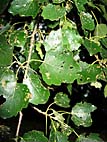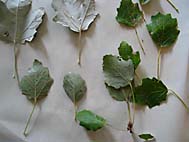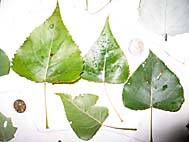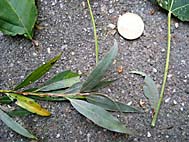Tree species that are common in the Dutch woods.
The keys in this site are meant to find that one tree amongst 100 others.
Most species however are rare: they are planted once in while in a garden or park.
On this page I feature the tree species that are common in the woods in the wild.
Big tree species you cna find in the woods: the top layer
Number one to fout are the birches,European white birch (and Downy birch ), The English oak and the European beech. The Red oak is also common.
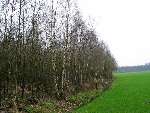
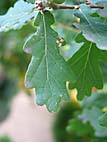
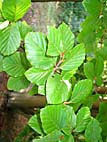
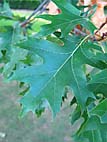 Birches are recognized by their white bark. The English oak is the most common tree and has a rough bark, lobed leafs and the acorns sit on a long stem. The European beech can grow to immense size, keeping its smooth bark and has smooth sinple leafs. Often mixed up with the Hornbeam. The Red oadk, or "American oak" in Dutch also has smooth bark but wit vertical whitish cracks like stripes. The leafs are lobed but with pointy ends.
Slightly less common but not rare at all are
Birches are recognized by their white bark. The English oak is the most common tree and has a rough bark, lobed leafs and the acorns sit on a long stem. The European beech can grow to immense size, keeping its smooth bark and has smooth sinple leafs. Often mixed up with the Hornbeam. The Red oadk, or "American oak" in Dutch also has smooth bark but wit vertical whitish cracks like stripes. The leafs are lobed but with pointy ends.
Slightly less common but not rare at all are Sweet cherry and Sycamore maple (common Maple in Dutch), Norway maple and the Hedge maple.
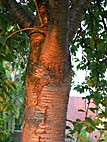
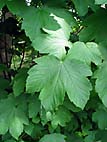
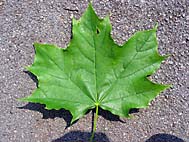
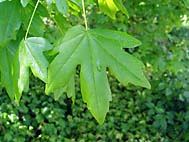
Last three are Maples. You can easily identify the sweet cherry by itsd bark which has typical smooth patches. The leafs are not small, elongated and toothed. Usually with a narrow crown. The maples have conspicuous leafs. The Hedge maple has much smaller leafs than the others. All maples have a smooth bark when they are young and a finely grained furrowed bark when they get bigger. The Sycamore maple often looses patches of bark when it gets pretty big. Less common but still often seen are the Common Ash and the Common Alder.
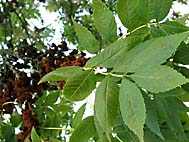
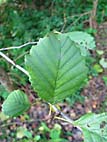
The common Alder is a slender tree which is often found on shores. It has typical blunt leafs and usually black or green Alder-bullets. It often has more trunks. The Ash is not really common in the woods but you see it now and then. It has a compound leaf and has fairly smoth bark. It often carries dense bushes of winged-fruit on its twigs. Trees you spot now and then are
Black locust and Aspen and the European hornbeam..
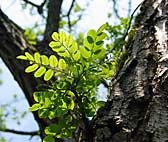
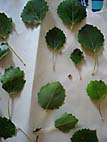
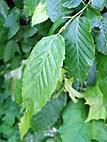 The Black locust can be easily distinguished by its very rough bark, often greyish. The compound leafs are characteritic roundish. It also carries thorns and flat green or brown beans as fruit. The Aspen is often rather slender in form, wit a grey bark and pretty equally shaped leafs. The European hornbeam is really very common, but is easy to miss. It looks a lot like the European Beech. Only the leafs have teeth, and the fruit is different. Its trunks seems to have budles of muscles under the bark: therefore probably the name muscle-wood.
Now and then you see a
The Black locust can be easily distinguished by its very rough bark, often greyish. The compound leafs are characteritic roundish. It also carries thorns and flat green or brown beans as fruit. The Aspen is often rather slender in form, wit a grey bark and pretty equally shaped leafs. The European hornbeam is really very common, but is easy to miss. It looks a lot like the European Beech. Only the leafs have teeth, and the fruit is different. Its trunks seems to have budles of muscles under the bark: therefore probably the name muscle-wood.
Now and then you see a Sweet chestnut or a Horse chestnut..
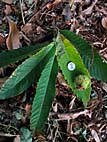
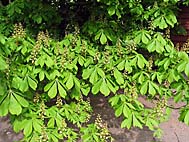 Both species are planted in the woods. The Sweet chestnut really origins in the middle-sea region and was imported by the Romans 2 millenia ago. You find a lot of them in Nijmegen as this was a Roman city long ago. The sweet chestnut has elongated toothed leafs and a really beautiful finegrained grey bark. The furrows are very smooth and evenly layed out. The Horse chestnut has big compound leafs that stand in a circle.
While this site does not do conifers I can mention the most common ones anyway:
De
Scots pine and
European and Japanse Larch. Good to spot form quite a long distance away. .
Both species are planted in the woods. The Sweet chestnut really origins in the middle-sea region and was imported by the Romans 2 millenia ago. You find a lot of them in Nijmegen as this was a Roman city long ago. The sweet chestnut has elongated toothed leafs and a really beautiful finegrained grey bark. The furrows are very smooth and evenly layed out. The Horse chestnut has big compound leafs that stand in a circle.
While this site does not do conifers I can mention the most common ones anyway:
De
Scots pine and
European and Japanse Larch. Good to spot form quite a long distance away. .
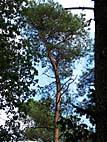
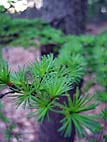 The netherlands are full of Scots pine: it has more needles in a bunch and small pineapples. The Larch is less common, but not rare at all. Its needles fall out in the authumn and turn beautifull yellow then.
The netherlands are full of Scots pine: it has more needles in a bunch and small pineapples. The Larch is less common, but not rare at all. Its needles fall out in the authumn and turn beautifull yellow then.
Bushes in the under-layer
The number of bush species is large in the Netherlands. Even those in the woods. I limit bushes here to those that can grow pretty large. Very common are the European Filbert, the European mountain ash the hawthorns and the Black elderberry (not the black adderberry).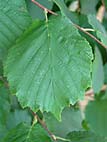
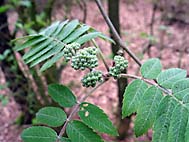
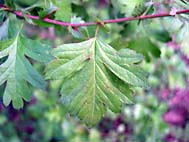
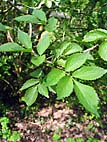 The European Filbert has big round/heartshaped like leafs wit teeth and is really everywhere. It can become several metres high and always has multiple trunks. The European mountainash is dispersed by birds by way of its berries ad is also everywhere. It has compound leafs.
The Hawthorns are common, however they are often planted. The Black elderberry can be easily recognized by its many berries and has also compound leafs and rough bark.
Tow species of trees and white compound screen of flowers in the spring: Wild cherry and Bird cherry.
The European Filbert has big round/heartshaped like leafs wit teeth and is really everywhere. It can become several metres high and always has multiple trunks. The European mountainash is dispersed by birds by way of its berries ad is also everywhere. It has compound leafs.
The Hawthorns are common, however they are often planted. The Black elderberry can be easily recognized by its many berries and has also compound leafs and rough bark.
Tow species of trees and white compound screen of flowers in the spring: Wild cherry and Bird cherry.
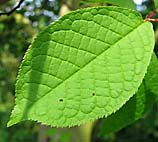
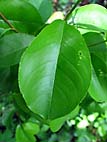 Both usualy rather small trees although they can grow upto 5 metres or so. Both have simple leafs. The wild cherry has leafs that are shiny and its bark smells bad when crushed. The Bird cherry has a very distinctive pattern of ribs in its leafs.
Planted, but often seen are the
Rododendron, with leather like leaves anbd beautifull flowers. Sometimes you see a whitebeam. with big toothed leafs that have whitish hairs on them. Its leafs reflect light.
Both usualy rather small trees although they can grow upto 5 metres or so. Both have simple leafs. The wild cherry has leafs that are shiny and its bark smells bad when crushed. The Bird cherry has a very distinctive pattern of ribs in its leafs.
Planted, but often seen are the
Rododendron, with leather like leaves anbd beautifull flowers. Sometimes you see a whitebeam. with big toothed leafs that have whitish hairs on them. Its leafs reflect light.
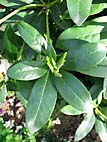
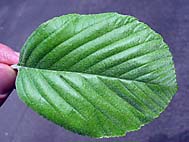
Trees you will find mostly in parks and along roads.
Trees you will find mostly in parks and along roads, bit sometimes in the wild are Bigleaf Linden | Common Linden | Smooth elm | Scatch elm | Dutch elm. |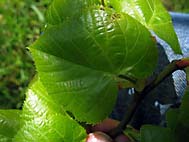
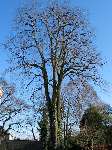
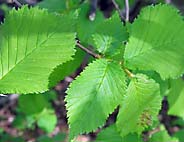
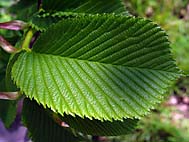
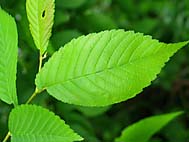 Grey poplar | White poplar |
Carolina poplar |
White willow..
Grey poplar | White poplar |
Carolina poplar |
White willow..
